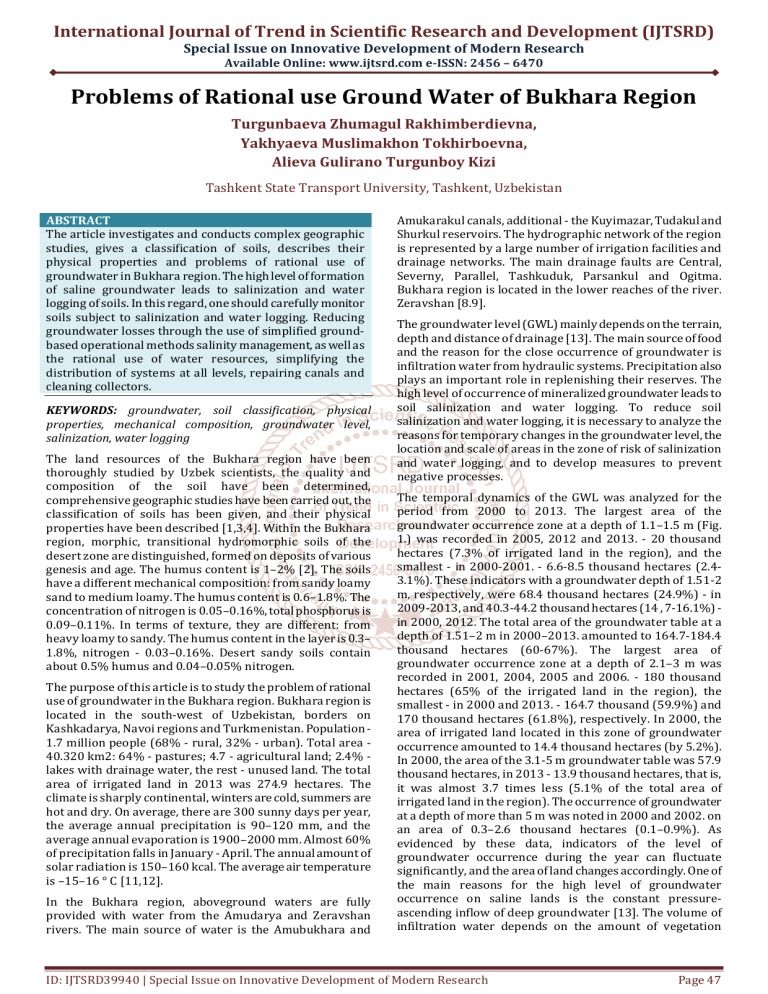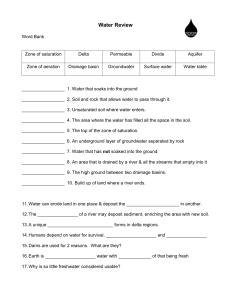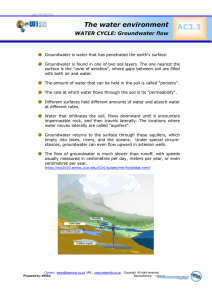
International Journal of Trend in Scientific Research and Development (IJTSRD) Special Issue on Innovative Development of Modern Research Available Online: www.ijtsrd.com e-ISSN: 2456 – 6470 Problems of Rational use Ground Water of Bukhara Region Turgunbaeva Zhumagul Rakhimberdievna, Yakhyaeva Muslimakhon Tokhirboevna, Alieva Gulirano Turgunboy Kizi Tashkent State Transport University, Tashkent, Uzbekistan ABSTRACT The article investigates and conducts complex geographic studies, gives a classification of soils, describes their physical properties and problems of rational use of groundwater in Bukhara region. The high level of formation of saline groundwater leads to salinization and water logging of soils. In this regard, one should carefully monitor soils subject to salinization and water logging. Reducing groundwater losses through the use of simplified groundbased operational methods salinity management, as well as the rational use of water resources, simplifying the distribution of systems at all levels, repairing canals and cleaning collectors. KEYWORDS: groundwater, soil classification, physical properties, mechanical composition, groundwater level, salinization, water logging The land resources of the Bukhara region have been thoroughly studied by Uzbek scientists, the quality and composition of the soil have been determined, comprehensive geographic studies have been carried out, the classification of soils has been given, and their physical properties have been described [1,3,4]. Within the Bukhara region, morphic, transitional hydromorphic soils of the desert zone are distinguished, formed on deposits of various genesis and age. The humus content is 1–2% [2]. The soils have a different mechanical composition: from sandy loamy sand to medium loamy. The humus content is 0.6–1.8%. The concentration of nitrogen is 0.05–0.16%, total phosphorus is 0.09–0.11%. In terms of texture, they are different: from heavy loamy to sandy. The humus content in the layer is 0.3– 1.8%, nitrogen - 0.03–0.16%. Desert sandy soils contain about 0.5% humus and 0.04–0.05% nitrogen. The purpose of this article is to study the problem of rational use of groundwater in the Bukhara region. Bukhara region is located in the south-west of Uzbekistan, borders on Kashkadarya, Navoi regions and Turkmenistan. Population 1.7 million people (68% - rural, 32% - urban). Total area 40.320 km2: 64% - pastures; 4.7 - agricultural land; 2.4% lakes with drainage water, the rest - unused land. The total area of irrigated land in 2013 was 274.9 hectares. The climate is sharply continental, winters are cold, summers are hot and dry. On average, there are 300 sunny days per year, the average annual precipitation is 90–120 mm, and the average annual evaporation is 1900–2000 mm. Almost 60% of precipitation falls in January - April. The annual amount of solar radiation is 150–160 kcal. The average air temperature is –15–16 ° С [11,12]. In the Bukhara region, aboveground waters are fully provided with water from the Amudarya and Zeravshan rivers. The main source of water is the Amubukhara and Amukarakul canals, additional - the Kuyimazar, Tudakul and Shurkul reservoirs. The hydrographic network of the region is represented by a large number of irrigation facilities and drainage networks. The main drainage faults are Central, Severny, Parallel, Tashkuduk, Parsankul and Ogitma. Bukhara region is located in the lower reaches of the river. Zeravshan [8.9]. The groundwater level (GWL) mainly depends on the terrain, depth and distance of drainage [13]. The main source of food and the reason for the close occurrence of groundwater is infiltration water from hydraulic systems. Precipitation also plays an important role in replenishing their reserves. The high level of occurrence of mineralized groundwater leads to soil salinization and water logging. To reduce soil salinization and water logging, it is necessary to analyze the reasons for temporary changes in the groundwater level, the location and scale of areas in the zone of risk of salinization and water logging, and to develop measures to prevent negative processes. The temporal dynamics of the GWL was analyzed for the period from 2000 to 2013. The largest area of the groundwater occurrence zone at a depth of 1.1–1.5 m (Fig. 1.) was recorded in 2005, 2012 and 2013. - 20 thousand hectares (7.3% of irrigated land in the region), and the smallest - in 2000-2001. - 6.6-8.5 thousand hectares (2.43.1%). These indicators with a groundwater depth of 1.51-2 m, respectively, were 68.4 thousand hectares (24.9%) - in 2009-2013, and 40.3-44.2 thousand hectares (14 , 7-16.1%) in 2000, 2012. The total area of the groundwater table at a depth of 1.51–2 m in 2000–2013. amounted to 164.7-184.4 thousand hectares (60-67%). The largest area of groundwater occurrence zone at a depth of 2.1–3 m was recorded in 2001, 2004, 2005 and 2006. - 180 thousand hectares (65% of the irrigated land in the region), the smallest - in 2000 and 2013. - 164.7 thousand (59.9%) and 170 thousand hectares (61.8%), respectively. In 2000, the area of irrigated land located in this zone of groundwater occurrence amounted to 14.4 thousand hectares (by 5.2%). In 2000, the area of the 3.1-5 m groundwater table was 57.9 thousand hectares, in 2013 - 13.9 thousand hectares, that is, it was almost 3.7 times less (5.1% of the total area of irrigated land in the region). The occurrence of groundwater at a depth of more than 5 m was noted in 2000 and 2002. on an area of 0.3–2.6 thousand hectares (0.1–0.9%). As evidenced by these data, indicators of the level of groundwater occurrence during the year can fluctuate significantly, and the area of land changes accordingly. One of the main reasons for the high level of groundwater occurrence on saline lands is the constant pressureascending inflow of deep groundwater [13]. The volume of infiltration water depends on the amount of vegetation ID: IJTSRD39940 | Special Issue on Innovative Development of Modern Research Page 47 International Journal of Trend in Scientific Research and Development (IJTSRD) @ www.ijtsrd.com eISSN: 2456-6470 irrigation, intensity and frequency of precipitation, waterphysical properties (permeability) of soils and rocks of the aeration zone [10]. The migration of waters infiltrating from the surface occurs until they reach the groundwater horizon, after which their vertical movement stops. They flow in the form of a soil flow towards the nearest natural drains (river valleys, gullies, ravines). When the infiltrated water reaches the groundwater basin, its level rises. As a result of a number of reasons - reservoir backwater, mass leaching of lands in spring with insufficient drainage, poor natural outflow of water from the territory and unsatisfactory condition of collectors, groundwater in the region is close to the surface almost all year round. Obstructed drainage and backwaters on collectors lead to a situation when the level of groundwater rises, and their outflow is impossible due to intensive use of land. If the salinity of groundwater is relatively low, then, provided the level of their occurrence is low, the secondary salinization of the soil will be minimal or not at all. Intensive leaching of the soil contributes to the prevention of excessive soil salinization, but this also causes an increase in the level and salinity of groundwater. The source of salt accumulation is water with a salinity of 1.0–1.5 g / l. Mineralization of the Amudarya water at the outlet from the mountains was 0.2– 0.3 g / l during the study period, and in the underlying territories - 1.0 and higher. The obstructed drainage and backwaters on the collectors lead to an increase in the level of groundwater and, as already mentioned above, due to the high coefficient of land use, their outflow is generally impossible. Large evaporation leads to strong soil salinization. Under these conditions, the regulation of the water-salt regime is extremely difficult. It should be noted that the land salinization of the Bukhara region is stable. Salinization is the result of irrational use of water resources [11, 14]. Soil leaching as a means of combating seasonal salinization under these conditions is ineffective due to the small capacity of the aeration zone and insufficient land drainage. In this case, the collectors are destroyed: slopes float and the bottom is poured. Arid conditions increase the transpiration of water and the accumulation of salts in the surface layer of the soil. From what has been studied, it follows that the closer to the surface of the ground the groundwater, the greater their participation in water consumption and the lower the need for water, that is, the number of vegetation irrigations and associated inter-row soil treatments decreases [5]. In addition, due to the high standing of groundwater, there is an intensive accumulation of salts in the upper layers of the soil [6,7]. The prevailing landscapes of the Bukhara region are characterized by weak natural drainage and insignificant land slopes (0.0001–0.0002). In the absence of good drainage, difficulties arise in lowering and removing groundwater, regulating the salt regime of soils. Due to operational difficulties, most of the existing drainage systems are malfunctioning or inoperative and approximately 50% of the vertical drainage is not used at all. The existing collectors quickly flooded and are now operating in a backwater mode, in connection with which the level of groundwater rises, there is a low efficiency of flushing, and an increase in soil salinity. In this regard, it is necessary to conduct careful monitoring of lands subject to secondary salinization. In addition, methods of ground-based simplified operational control of salinity should be widely used in order to prevent it in specific fields during the growing season, as well as rational use of water resources, reduce unproductive water losses by streamlining its distribution at all levels of systems, repairing canals and cleaning collectors [15]. BIBLIOGRAPHY [1] Abdullaev S. Agrophysical properties and salt regime of irrigated soils in oases of Bukhara region: Author's abstract. dis ... cand. s.-kh. sciences. Tashkent, 1975. [2] Atlas of soils of Uzbekistan. Bukhara region. Tashkent, 2012. [3] Zvonkova T. V. Bukhara region. Natural conditions and resources of South-West Uzbekistan. Tashkent: Fan, 1965. [4] Lebedev Yu. P. Soils of irrigated oases in the lower Zeravshan // Scientific. tr. Aral-Caspian complex expedition. Issue 1. Moscow: Publishing House of the Academy of Sciences of the USSR, 1954. [5] Nigmatov A. N. Geoecological aspects of contamination and technogenic disturbance of the lands of Uzbekistan. Tashkent, 2005. [6] Panin P. S. Salt release processes in washed soil strata. Novosibirsk: Science, 1968. [7] Pankova E. I., Aydarov I. P., Yamnova I. A. and others. Natural zoning of saline soils in the Aral Sea basin (geography, genesis, evolution). M., 1996. [8] Shirokova Yu. I., Chernyshev A. K. Express method for determining the salinity of soil and water in the conditions of Uzbekistan // Agriculture of Uzbekistan. 1999. No. 5. [9] Shodiev S. R. Hydrochemistry of river and collectordrainage waters in the south-west of Uzbekistan: Author's abstract. dis ... cand. s.-kh. sciences. Tashkent, 2009. [10] Eshchanov R. Agroecological foundations of sustainable use of land and water resources (on the example of the Khorezm region): Author. dis ... Dr. s.kh. sciences. Tashkent, 2008. [11] Alihanov B. B. About a Condition of Environment and Use of Natural Resources in Republic of Uzbekistan (the Retrospective Analysis for 1988-2007), National Report of the State Committee for Nature Protection of the Republic of Uzbekistan. Tashkent: Chinor ENK, 2008. [12] Chub V., Osokova T. Second National Report of the Republic of Uzbekistan on UN FCCC. Tashkent, 2008. [13] Kulmatov R. Problems of Sustainable Use and Management of Water and Land Resources in Uzbekistan // Journal of Water Resource and Protection. 2014.6. [14] Umarov N. U. About a Condition of Environment and Use of Natural Resources in Republic of Uzbekistan (the Retrospective Analysis for 2008-2011), National Report of the State Committee for Nature Protection of the Republic of Uzbekistan. Tashkent: Chinor ENK, 2013. ID: IJTSRD39940 | Special Issue on Innovative Development of Modern Research Page 48 International Journal of Trend in Scientific Research and Development (IJTSRD) @ www.ijtsrd.com eISSN: 2456-6470 [15] R. A. Kulmatov, A. B. Rasulov, A. N. Nigmatov "Problems of rational use irrigated lands of the Bukhara region of Uzbekistan "2014, 18-25s. [16] Aminov, A. S., Shukurov, A. R., & Mamurova, D. I. (2021). Problems of Developing the Most Important Didactic Tool for Activating the Learning Process of Students in the Educational Process. International Journal of Progressive Sciences and Technologies, 25(1), 156-159. [17] Khodieva, Orzigul Shodimurodovna, and Sohib Salimovich Sharipov. "The history of the creation of the author's lexicography." Middle European Scientific Bulletin 9 (2021). [18] Botirov, Jahongir Sobirovich, et al. "The same goes for art classes in private schools specific properties." Journal of Contemporary Issues in Business and Government 27.2 (2021): 1643-1650. ID: IJTSRD39940 | Special Issue on Innovative Development of Modern Research Page 49







